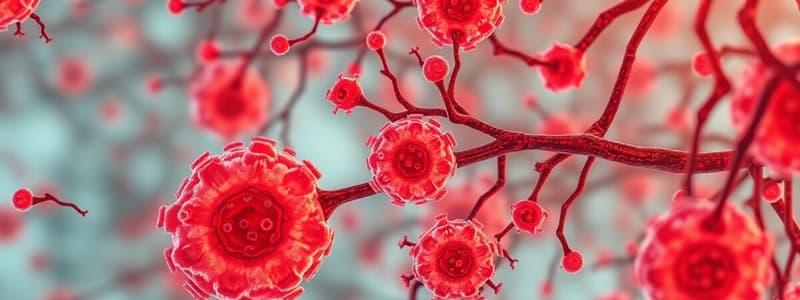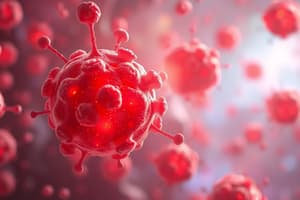Podcast
Questions and Answers
What is the primary mechanism responsible for leukocyte migration towards a source of injury?
What is the primary mechanism responsible for leukocyte migration towards a source of injury?
- Random movement
- Passive diffusion
- Chemotaxis (correct)
- Hydrostatic pressure
Which of these events occurs first in the process of leukocyte recruitment?
Which of these events occurs first in the process of leukocyte recruitment?
- Margination and rolling along the vessel wall (correct)
- Firm adhesion to the endothelium
- Migration in interstitial tissues
- Transmigration between endothelial cells
What is the role of opsonins in phagocytosis?
What is the role of opsonins in phagocytosis?
- Promoting transmigration of leukocytes
- Enhancing the engulfment of the particle by leukocytes (correct)
- Directly killing the ingested material
- Activating the leukocytes to release inflammatory mediators
Which of the following is NOT a stimulus for leukocyte activation?
Which of the following is NOT a stimulus for leukocyte activation?
Which of these is a key characteristic of the resolution phase in acute inflammation?
Which of these is a key characteristic of the resolution phase in acute inflammation?
What is the primary function of leukocytes in the body?
What is the primary function of leukocytes in the body?
Which of these statements about leukocyte recruitment is TRUE?
Which of these statements about leukocyte recruitment is TRUE?
What is the main benefit of the checks and balances in host defense mechanisms?
What is the main benefit of the checks and balances in host defense mechanisms?
What typically occurs following acute inflammation if the offending agent is not removed?
What typically occurs following acute inflammation if the offending agent is not removed?
What characterizes fibrinous inflammation?
What characterizes fibrinous inflammation?
What results from severe tissue destruction due to inflammation?
What results from severe tissue destruction due to inflammation?
What describes suppurative inflammation and abscess formation?
What describes suppurative inflammation and abscess formation?
What is an ulcer?
What is an ulcer?
What is the primary goal of the inflammatory response?
What is the primary goal of the inflammatory response?
What characterizes acute inflammation?
What characterizes acute inflammation?
Which of the following is NOT a common stimulus for acute inflammation?
Which of the following is NOT a common stimulus for acute inflammation?
Which cells are primarily involved in the recognition of infectious pathogens during inflammation?
Which cells are primarily involved in the recognition of infectious pathogens during inflammation?
What is a defining feature of chronic inflammation?
What is a defining feature of chronic inflammation?
Which of the following conditions will NOT typically elicit an inflammatory response?
Which of the following conditions will NOT typically elicit an inflammatory response?
Which type of leukocyte is predominantly involved in acute inflammatory responses?
Which type of leukocyte is predominantly involved in acute inflammatory responses?
What role do resident cells of vascular walls play in inflammation?
What role do resident cells of vascular walls play in inflammation?
What is the primary function of pattern recognition receptors in the immune system?
What is the primary function of pattern recognition receptors in the immune system?
Which process is responsible for the redness and warmth seen in acute inflammation?
Which process is responsible for the redness and warmth seen in acute inflammation?
What distinguishes an exudate from a transudate?
What distinguishes an exudate from a transudate?
Which of the following occurs during leukocyte recruitment in inflammation?
Which of the following occurs during leukocyte recruitment in inflammation?
What is primarily responsible for the increased vascular permeability during inflammation?
What is primarily responsible for the increased vascular permeability during inflammation?
How do transudates typically form in relation to hydrostatic pressure?
How do transudates typically form in relation to hydrostatic pressure?
What potential negative consequence can arise from leukocyte activity during inflammation?
What potential negative consequence can arise from leukocyte activity during inflammation?
Which vascular change is NOT part of the acute inflammatory response?
Which vascular change is NOT part of the acute inflammatory response?
Flashcards
Inflammation
Inflammation
A protective host response to eliminate invaders and repair injury.
Acute Inflammation
Acute Inflammation
Rapid onset inflammation lasting from minutes to days, characterized by neutrophils.
Chronic Inflammation
Chronic Inflammation
Prolonged inflammation lasting days to years, marked by lymphocytes and macrophages.
Stimuli for Acute Inflammation
Stimuli for Acute Inflammation
Signup and view all the flashcards
Phagocytes
Phagocytes
Signup and view all the flashcards
Dendritic Cells
Dendritic Cells
Signup and view all the flashcards
Neutrophils
Neutrophils
Signup and view all the flashcards
Macrophages
Macrophages
Signup and view all the flashcards
Host Defense Mechanisms
Host Defense Mechanisms
Signup and view all the flashcards
Leukocyte Recruitment
Leukocyte Recruitment
Signup and view all the flashcards
Phagocytosis
Phagocytosis
Signup and view all the flashcards
Margination
Margination
Signup and view all the flashcards
Transmigration
Transmigration
Signup and view all the flashcards
Leukocyte Activation
Leukocyte Activation
Signup and view all the flashcards
Chemical Mediators
Chemical Mediators
Signup and view all the flashcards
Outcomes of Acute Inflammation
Outcomes of Acute Inflammation
Signup and view all the flashcards
Scarring
Scarring
Signup and view all the flashcards
Serous Inflammation
Serous Inflammation
Signup and view all the flashcards
Fibrinous Inflammation
Fibrinous Inflammation
Signup and view all the flashcards
Suppurative Inflammation
Suppurative Inflammation
Signup and view all the flashcards
Pattern Recognition Receptors
Pattern Recognition Receptors
Signup and view all the flashcards
Vasodilation
Vasodilation
Signup and view all the flashcards
Erythema
Erythema
Signup and view all the flashcards
Transudate
Transudate
Signup and view all the flashcards
Exudate
Exudate
Signup and view all the flashcards
Tissue Edema
Tissue Edema
Signup and view all the flashcards
Study Notes
Inflammation
- Inflammation is a complex host response to eliminate foreign invaders
- It's a protective response involving host cells, blood vessels, and proteins
- The goal is to eliminate the cause of injury, necrotic cells, and tissues, initiating repair
- Inflammation accomplishes this by diluting, destroying, or neutralizing harmful agents (e.g., microbes, toxins)
Classification of Inflammation
- Acute inflammation: rapid onset, short duration (minutes to days)
- Characterized by fluid and protein exudation and neutrophilic leukocyte accumulation
- Chronic inflammation: insidious, longer duration (days to years)
- Characterized by influx of lymphocytes and macrophages, vascular proliferation, and fibrosis (scarring)
Stimuli for Acute Inflammation
- Infections (bacterial, viral, fungal, parasitic)
- Trauma (blunt and penetrating)
- Tissue necrosis (from any cause, including ischemia)
- Foreign bodies (splinters, dirt, sutures)
- Immune reactions (hypersensitivity)
Recognition of Microbes, Necrotic Cells and Foreign Substances
- Phagocytes, dendritic cells, and epithelial cells recognize infectious pathogens and substances from dead cells
- Pattern recognition receptors identify common structures on microbes and dead cells
- Examples include Toll-like receptors and the inflammasome
Vascular Changes
- Increased blood flow (vasodilation) and vascular permeability
- Bringing blood cells and proteins to sites of injury or infection
- First, brief vasoconstriction, then vasodilation
- Local increase in blood flow, engorgement of capillaries
- Redness (erythema) and warmth result from this expansion
- Local increase in blood flow, engorgement of capillaries
- Increased vascular permeability leads to protein rich fluid escaping into extravascular tissue
- Exudate (high protein content, white and red blood cells) vs transudate (low protein content, few cells)
- Fluid accumulation in tissues, causing edema
Cellular Events: Leukocyte Recruitment and Activation
- Leukocytes are delivered to sites of injury or activation
- Ingest offending agents, kill microbes, and eliminate necrotic tissue
- Can induce tissue damage and prolong inflammation
- Host defense mechanisms have regulatory checks and balances
Leukocyte Recruitment
- Leukocytes move from the blood stream to the site of injury (extravascular space)
- Sequence includes:
- Margination and rolling along vessel walls
- Firm adhesion to endothelium
- Transmigration between endothelial cells
- Migration into interstitial tissues following a chemotactic stimulus
- Chemical mediators (chemoattractants and cytokines) influence adhesion molecules, binding affinity of leukocytes, and directional movement
Leukocyte Activation
- Recruitment to sites of infection or tissue necrosis
- Activation necessary for their functions
- Stimuli include microbes, products of necrotic cells, and mediators
- Various receptors on leukocytes detect microbes, dead cells, and foreign substances
- Inducing responses part of normal defensive functions, grouped under 'activation'
Phagocytosis
- Three steps in phagocytosis:
- Recognition and attachment of the particle (microbes, dead cells) to the leukocyte via opsonins.
- Engulfment, forming a phagocytic vacuole
- Killing and degradation of the ingested material within lysosomes.
Outcomes of Acute Inflammation
- Resolution: Regeneration and repair if injury limited
- Chronic inflammation: if the offending agent is not removed; repair or scarring may result
- Scarring: Tissue destruction leads to connective tissue filling (fibrosis)
Morphologic Patterns of Acute Inflammation
- Serous inflammation: Watery, protein-poor fluid (e.g., blisters)
- Fibrinous inflammation: Large amounts of fibrinogen allowing leakage (severe injury)
- Suppurative (purulent) inflammation: Pus formation (e.g., abscesses); neutrophils, necrotic cells, edema fluid
- Focal collections of pus caused by pyogenic organisms, or as secondary infections of necrotic tissue
- Ulcers: Local defects in tissue surfaces due to cell necrosis and shedding
Studying That Suits You
Use AI to generate personalized quizzes and flashcards to suit your learning preferences.




